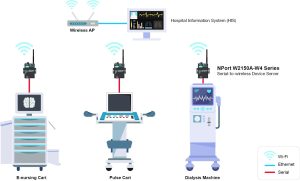-moxa.com
Thanks to the type of technology around these days, medical industries are now quickly moving toward digitalization. The need to reduce manual errors and increase operational efficiency spurs this digitalization drive that prioritizes the development of electrical health records (EHRs). In addition, COVID-19 has sped up the demand for EHRs so that medical staff can receive patient information effortlessly in real time, helping them to work more efficiently.
Developing EHRs, however, requires collecting a large amount of data from many medical machines scattered around multiple hospital buildings. Hence, many hospital operators are now developing their hospital information systems (HISs) to collect data from these widely distributed medical machines and turn valuable data into EHRs. As a lot of medical machines come with serial interfaces, they rely on serial-to-Ethernet communication to accommodate a modern HIS. These machines range from dialysis machines and monitoring systems for blood glucose, blood pressure, etc. to medical carts, diagnostic mobile workstations, ventilators, anesthesia machines, ECGs, and more. Developing a reliable communication system between HIS and medical machines is therefore crucial. Without reliable connections, a HIS cannot receive accurate data on time to conduct a qualified EHR. Such situations lead to poor diagnostics and a slower treatment process, defeating the purpose of developing EHRs. As serial device servers play a critical role in data transfer between serial-based medical machines and an Ethernet-based HIS, choosing a reliable serial device server is important to enable reliable connectivity. In this article, we will discuss three considerations that deserve your attention when choosing connectivity solutions to develop a HIS and how these solutions help.
Consideration 1: Difficult to Connect With Constantly Moving Medical Machines
Many medical machines require constant moving from one room to another to serve different patients. Wireless communications can solve connectivity issues for these mobile medical machines. Thus, using a serial device server that supports wireless connections can help you connect your mobile medical machines to a HIS through wireless networks. Despite its convenience, it is challenging to keep wireless connections stable. If you choose to develop wireless networks, you need to have sufficient APs in your hospital so that your medical machines can stay connected while moving them around. When medical machines move between different APs, your serial-to-wireless device servers require fast roaming between them to reduce switching time and minimize the chances of being disconnected. Once a wireless disconnection and instability occur, the port buffering function can be a bonus for your serial-to-wireless communication, because it allows you to store the serial data and resent it when the wireless connection resumes. Thus, when you choose a serial-to-wireless device server, check if it has this function, as it can be a great help for HISs in collecting complete serial data from medical machines.
Consideration 2: Protect Sensitive Patient Information From Unauthorized Access
Enabling communication enhances efficiency, but it also comes with increasing security concerns. Serial data in hospitals includes sensitive patient information that requires proper protection. So, when you choose your serial-to-wireless device servers, ensure they can protect your data during wireless transmissions. A feature to look out for is the support of the WPA2 protocol to build a secured wireless connection that encrypts your serial data over wireless networks. In addition, your serial-to-wireless device servers should also support secure boots that only allow authorized firmware to run on your devices, minimizing the chances of getting hacked.
Consideration 3: Protect Communication Systems From Interruptions
Medical machines have a low tolerance for system downtime. Thus, the serial-to-wireless device servers you choose should be reliable enough to minimize system downtime. Providing a locking screw for stable power input against constant shocks to and vibrations of moving medical carts should be a key feature. In addition, features such as surge protection for your serial ports, power inputs, and LAN ports also enhance reliability and reduce system downtime.
Your Secure and Reliable Serial-to-wireless Device Servers
Our NPort W2150A-W4/W2250A-W4 Series serial-to-wireless device server provides secure and reliable serial-to-wireless communications for your HIS. They provide 802.11 a/b/g/n dual band network connections that easily enable your serial-based medical machines to connect with a modern HIS. To reduce packet loss over wireless networks, our serial-to-wireless device servers support a fast roaming function, enabling seamless connectivity for the constantly moving medical carts between different wireless APs. In addition, our offline port buffering function provides up to 20 MB to store your data when the wireless connection is unstable. To protect sensitive patient information, our serial-to-wireless device servers support secure boots and WPA2 protocol to enhance both device security and wireless transmission security.
As an industrial connectivity solution provider, our serial-to-wireless device servers provide locking screws with power inputs and surge protection to enhance device reliability for reducing the chances of system downtime.
NPort W2150A-W4/W2250A-W4 Series Serial-to-wireless Device Servers
- Link serial and Ethernet devices to an IEEE 802.11a/b/g/n network
- Web-based configuration using built-in Ethernet or WLAN
- Secure boot for only Moxa authorized firmware allowed to run
- Secure data access with WEP, WPA, WPA2
- Fast roaming for quick automatic switching between access points
- Offline port buffering and serial data log
- Enhanced surge protection for serial, LAN, and power
- Dual power inputs (1 screw-type power jack, 1 terminal block)
- 5-year warranty to ensure product longevity and quality
Moxa is committed to providing serial connectivity solutions that easily take your serial devices into the future of networking. We continue to develop new technologies, support a variety of OS drivers, and enhance cybersecurity features, committing to provide serial connectivity for you to the year 2030 and beyond.
Source: https://www.moxa.com/en/articles/considerations-for-developing-reliable-hospital-information-systems









